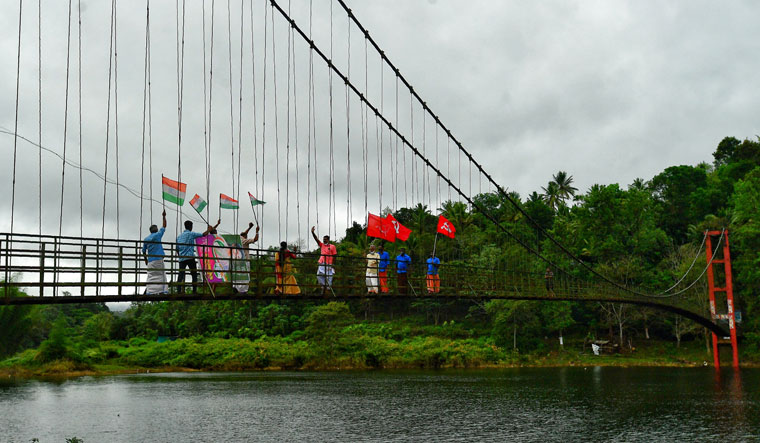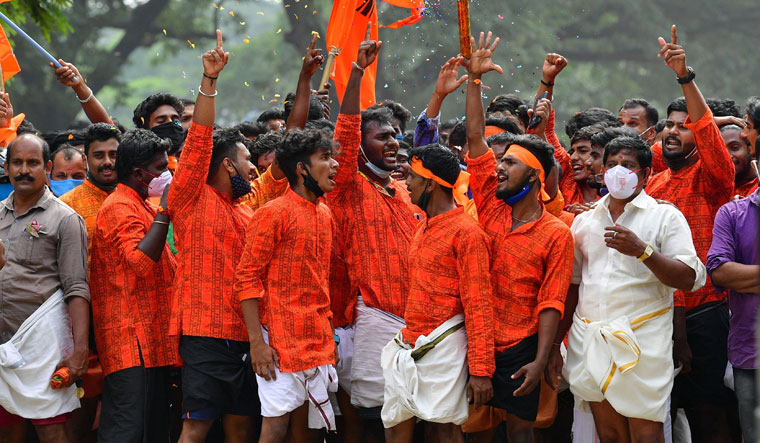The 1980s had been a turning point in Kerala history. It was the decade in which Mammootty and Mohanlal established themselves as the undisputed superstars of the Malayalam film industry. The decade also saw Kerala’s predominant political formations—the Congress-led United Democratic front (UDF) and the CPI(M)-led Left Democratic Front (LDF)—becoming entrenched in the state’s political landscape. The people of Kerala loved this duopoly—in politics and in cinema. Well, at least, till recently.
The Malayalam film industry is undergoing a huge churn. A new generation of filmmakers and actors are changing the very lingo and grammar of the industry. Something similar is happening to the UDF-LDF binary, too. The duo had been the only players in Kerala politics, capturing power alternately in every election held since 1980. The BJP has been trying to break their dominance and establish itself as a major player, backed by its undisputed hold over power in Delhi. The saffron party’s presence is gradually changing the way politics is being played out in the state.
The BJP has just one seat in the Kerala legislative assembly, but it has broken the political equilibrium the state maintained for the last 40 years. The party enjoys an oversized presence in the media, which has forced the opposition Congress to repeatedly insist that it is the primary challenger of the ruling LDF.
“The fight is between the LDF and the BJP. The UDF is a distant third,” BJP state president K. Surendran told THE WEEK. “Opposition leader Ramesh Chennithala only repeats what I say in news conferences. The 2021 assembly elections will seal the fate of the decades-long UDF versus LDF pattern.”
Surendran’s talk, however, do not match the returns his party got in the recent local body elections. The ruling LDF swept the elections, while the UDF managed to slightly improve its tally in the panchayats when the results were announced on December 16. The BJP finished way behind the two major fronts. But the party is no longer an ‘also-ran’ in Kerala. It is already a big winner in the battle of perception and with unstinted support from Delhi—in terms of money and access to power—the party’s presence is getting wider and deeper.
“The so-called ‘apolitical/neutral’ voters, who are decisive in every election, see both the UDF and the LDF as corrupt. There is a strong chance that they may prefer a third front, provided the BJP has a winning quotient,” said writer and political commentator M.N. Karassery. “I will not be surprised if the BJP replaces one of the existing coalitions by the 2026 elections,” he said.
The UDF and the LDF have realised that the performance in this year’s assembly elections will be a matter of survival for both. They are worried that if one of them loses by a huge margin, the losing coalition’s demoralised followers may drift to the BJP, especially if it retains power in the 2024 Lok Sabha elections. The BJP’s growing presence has already compelled both fronts to resort to unprecedented manoeuvres. The LDF’s decision to induct the Kerala Congress (M), a party against which it had run strident anti-corruption campaigns in the past, to the coalition and the UDF’s move to have an informal alliance with the Welfare Party of India, backed by the Jamaat-e-Islami, should be seen in this context.
LDF leaders alleged that the BJP was attempting a ‘Bengal model’ against the front. “The BJP used Mamata Banerjee to gain a foothold in West Bengal. Once they succeeded in that, they turned against Mamata,” said M.B. Rajesh, CPI(M) leader and former MP. “Similarly, the BJP is tacitly using the UDF to defeat the left as it knows that it will not be able to capture Kerala’s secular space as long as the left is strong. The Congress leadership in Kerala is very myopic and is colluding with the BJP.”
Writer Paul Zacharia said the left was the BJP’s arch enemy because its ideology had played a huge role in shaping Kerala’s secular space. “The left offers the strongest buffer against the BJP because of its ideology and the strong cadre. Once the left is decimated, Kerala would be a cakewalk for the BJP,’’ he said.
Congress leaders, however, said the CPI(M) was targeting UDF leaders to help the BJP. “It is the CPI(M) which is trying to decimate the Congress to help the BJP,” said senior Congress leader V.D. Satheesan. But Surendran said the LDF government was forced to take action against UDF leaders accused of corruption because of the BJP. “But for our presence, the UDF and the LDF would have continued with their ‘adjustment politics’, which has been going on for the past four decades,” he said.
The BJP has to a great extent managed to deepen the divide between Christians and Muslims, Kerala’s two powerful minority communities. Their presence has been a major stumbling block for the BJP to expand its reach in Kerala. The Christian and Muslim communities, which are politically and economically powerful, have been the backbone of the UDF despite the fact that there has not been much love lost between the two. “Common interests had brought the two communities together despite their mutual mistrust. But the BJP, which knows that it has to divide the two to capture Kerala, is using every possible tool—from the Hagia Sophia issue and the Armenia-Azerbaijan conflict to controversies surrounding the alleged ‘love jihad’—to deepen the divide. And it seems to be succeeding,” said political observer A. Jayashankar.
The BJP is also making inroads into Kerala’s sociocultural space. “Kerala’s cultural space is gradually welcoming the RSS and its ideology, which is happening in a subtle manner. This could have multiple repercussions as Kerala is one of those rare spaces where statements by literary and cultural personalities still get frontpage displays,’’ said writer Shajahan Madampat.
A well-known filmmaker said being seen as an RSS sympathiser was no longer a stigma, a huge change for Kerala’s social psyche. “If symbols affiliated to the RSS were “smuggled” into Malayalam films or literature in the past, those are being openly paraded these days. It reflects the transformation the Kerala society is undergoing,” he said.
The fact that the BJP-led National Democratic Alliance managed to garner 15.2 per cent votes in the 2019 general elections is being looked at seriously by political observers. The saffron alliance polled 14.6 per cent votes in the local body elections. “Almost the entire chunk of its votes must have come from the Hindu community and it shows that nearly 30 per cent of the Hindus have accepted the BJP as their natural choice even when its winning quotient is very low,” said Madampat. He blamed the “overt religious posturing” and identity assertion of the minority communities—a very visible thing in Kerala—for helping the BJP in creating a divide between the majority and the minorities. “More than any proselytisation attempt, it is the extreme show of organisational might and material exhibitionism, thanks to expats in the Gulf and in the west, which helped the BJP make Hindus feel insecure,” he said.
So, will the BJP capture Kerala? While the BJP’s presence is growing in all spheres—social, political and cultural—the party lacks winnability quotient. And its adversaries, despite their obvious weaknesses, are well entrenched. The Congress and the CPI(M) have strong organisational structures in Kerala which are active from top to bottom, unlike in other parts of the country. “The Congress that the BJP is fighting in Kerala is not a loose structure that it fought in other states. Similarly, the CPI(M) in Kerala is one of the strongest cadre-based parties in the country. So the BJP will have to really sweat it out to displace one of them,” said Satheesh Chandran, a political observer.
Satheesan, too, echoed similar sentiments. “The BJP may be a strong presence on television screens and newspapers. But on the ground, apart from a few pockets, there are only two fronts in Kerala—the UDF and the LDF,” he said. The presence of the powerful minority communities, too, hinders the BJP’s progress. “The BJP may try all tricks possible to divide them but it will not work,” said C.P. John, a UDF leader.
Most political observers believe that the BJP’s performance in the upcoming assembly elections is likely to resemble its performance in the 2019 general elections, when it spearheaded an aggressive campaign against the LDF government, especially on the sensitive issue of allowing women entry into the Sabarimala shrine. But it drew a blank, and the UDF swept the state with 19 of 20 seats.
Kerala’s political history also does not favour the BJP. “Kerala has bucked the national trend except in the 1984 and 1991 general elections,” said political observer and academic K. Jayaprasad. “While most of India voted against Indira Gandhi in the 1977 elections after the Emergency, Kerala gave an overwhelming mandate for the Congress. In 1965, it gave more seats to communists [in the assembly polls], although the elections were held immediately after the war with China. The same happened in the 2014 and 2019 general elections. It is in Kerala’s political DNA to stand apart.”
Jayaprasad said other than the presence of the minorities, what was hurting the BJP the most was the structure and character of the Hindu community in the state. “Kerala Hindus are deeply political and most of them are close to the left parties. Equally important is the fact that all communities within the Hindu fold are already powerful, both socially and economically. They do not need the BJP to empower them. That is why the BJP’s social engineering tactics, which is working elsewhere in the country, have failed in Kerala,” said Jayaprasad.
The BJP also faces a major leadership crisis in Kerala. Jayashankar said the party was unlikely to win with its current crop of leaders. The recent local body elections have shown that there is no correlation between the BJP’s high decibel presence on television screens and social media, and the number of votes it polled. Still, the party managed to win two municipalities, four panchayats and is the single largest party in seven panchayats. It added 395 more seats compared with the 2015 local body polls. Still, the gains hardly match the massive effort put in by the party’s central leadership.
“The BJP has become a strong presence in Kerala in the last few years. But this would be of no significance if it is not translated into votes,” said Zacharia. “After all, what ultimately counts is the number of seats you win.”
A senior RSS pracharak told THE WEEK that not everything was going in the BJP’s favour at the moment. “There are many positive factors for the BJP in Kerala, but some stumbling blocks remain,” he said. When asked whether it was the much repeated ‘secular’ character of Kerala that is stopping the BJP, his answer was cryptic. “The RSS is a very patient organisation,” he said. “We waited for decades to get one seat in Kerala. We don’t mind waiting a few more years to capture the state.”
The RSS is correct in believing that the political climate in Kerala is gradually moving away from the LDF versus UDF binary. The Malayalam film industry, too, has started looking beyond Mammootty and Mohanlal. Yet, for the time being, they are Kerala’s only superstars, just as the UDF and the LDF are the only political fronts that really matter.



